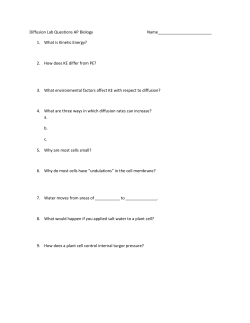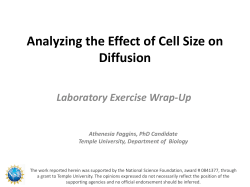
Relaxation times
Institute for Biomedical Engineering EXCITE Afternoon Hands-On MRI Sessions: fMRI & DTI Institute for Biomedical Engineering Contrast in MRI - Relevant Parameters Relaxation times: T1 Spin-lattice relaxation time (longitudinal relaxation time) Return of spin system to equilibrium state T2 Spin-spin relaxation time (transverse relaxation time) Loss of phase coherence due to fluctuations of interacting spins (‘phase memory time’) T2* Decay time of free induction decay Signal loss due to magnetic field inhomogeneity (difference in magnetic susceptibility) ADC Apparent diffusion coefficient Signal loss due to diffusion of water molecules in an inhomogeneous magnetic field k water exchange rate Exchange of water between macromolecule bound fraction and bulk (free) water Institute for Biomedical Engineering Relations and Limitations Sensitivity: Signal-to-Noise Ratio (SNR) Spatial resolution Temporal resolution Signal: magnetization (number of spins, magnetic field strength, …. ) Noise: thermal noise of receiver system, physiological noise, … Institute for Biomedical Engineering MRI Contrast IBT Institute for Biomedical Engineering Relaxation times MRI delivers good soft tissue contrast Tissue specific magnetic parameters for contrast generation T2 / T2*: how fast is signal lost after excitation T1: how fast is magnetization gained back after excitation for next experiments Sequence parameters and sequence type determine contrast Institute for Biomedical Engineering The NMR signal +1.0 Mz My Mx 1-exp(-t/T1) Relaxation Mi(t)/Meq Relaxation 0.0 exp(-t/T2*) -1.0 0 0.5 time (s) 1.0 0 0.5 time (s) 1.0 0 0.5 time (s) 1.0 Institute for Biomedical Engineering T1 weighting Relevant parameters: Repetition time (TR) = time between two excitations Flip angle -> how much magnetization is left for next excitation Strong T1 weighting for large flip angle and short TR Mz MzA θ T1 Relaxation during TR MzB Mxy Institute for Biomedical Engineering T1 weighting: Example Two metabolites with T1=500ms (blue) and T1=250ms (red) Flip angle: 60° Signal proportional to DMz TR=3000ms Mz time 01.04.2010 IBT 8 Institute for Biomedical Engineering T1 weighting: Example Two metabolites with T1=500ms (blue) and T1=250ms (red) Flip angle: 60° Signal proportional to DMz TR=300ms Mz time 01.04.2010 IBT 9 Institute for Biomedical Engineering T1 weighting: Example Two metabolites with T1=500ms (blue) and T1=250ms (red) Flip angle: 60° Signal proportional to DMz TR=100ms Mz time 01.04.2010 IBT 10 Institute for Biomedical Engineering T2 / T2* weighting Relevant parameter: Echo time (TE) = time between excitations and data acquisition Strong T2 weighting for long TE Mxy t / ms TEshort TEmedium TElong Institute for Biomedical Engineering Proton density weighting Intensity scales with number of signal generating nuclei per volume element Keep influence of relaxation times small: Short TE -> small effect of T2 / T2* on signal Long TR -> small effect of T1 Institute for Biomedical Engineering Functional MRI (fMRI) IBT Functional MRI (fMRI) Institute for Biomedical Engineering Uses echo planar imaging (EPI) for fast acquisition of T2*-weighted images. Spatial resolution: 3 mm < 200 μm (standard 1.5 T scanner) (high-field systems) EPI (T2*) Sampling speed: 1 slice: 50-100 ms dropout Problems: distortion and signal dropouts in certain regions sensitive to head motion of subjects during scanning Requires spatial pre-processing and statistical analysis. T1 But what is it that makes T2* weighted images “functional”? IBT 14 The BOLD contrast Institute for Biomedical Engineering REST neural activity blood flow oxyhemoglobin T2* MR signal ACTIVITY Source: Jorge Jovicich, fMRIB Brief Introduction to fMRI Institute for Biomedical Engineering The temporal properties of the BOLD signal sometimes shows initial undershoot peaks after 4-6 secs back to baseline after approx. 30 secs can vary between regions and subjects Peak Brief Stimulus Undershoot Initial Undershoot Institute for Biomedical Engineering MRI and Diffusion IBT Institute for Biomedical Engineering Brownian motion Molecules or atoms in fluids and gases move freely Collisions with other particles causes trembling movement Brownian motion: microscopic random walk of particles in fluids of gases (R. Brown 1827) Brownian motion depends on thermal energy, particle properties and fluid density Institute for Biomedical Engineering Diffusion Diffusion: irreversible automatic mixing of fluids (or gases) due to Brownian motion Root mean square displacement depends on diffusion coefficient D and time t: r 2 D t (A. Einstein) Diffusion coefficient D affected by cell membranes, organelles, macromolecules (Le Bihan 1995) Institute for Biomedical Engineering Anisotropy Restrictions on water diffusion usually without spherical symmetry anisotropic diffusion in biological tissue Diffusion tensor (=3x3-matrix) instead of diffusion coefficient accounts for anisotropic diffusion in 3D Principal diffusion direction: direction with largest diffusion coefficient r1 r2 r3 Free Diffusion Restricted Diffusion ri 2 Di t , i 1, 2,3 Institute for Biomedical Engineering Example: nerve fibre Diffusion perpendicular to fibre restricted Water diffusion indicates white matter organization Institute for Biomedical Engineering Diffusion and MRI Diffusion leads to signal loss in MRI Institute for Biomedical Engineering Diffusion gradients Signal attenuation depends on diffusion coefficient and gradient waveforms GE: sum of diffusion weighting gradients zero SE: diffusion weighting gradients have equal area Single shot techniques freeze out physical motion 90° diffusion gradient 180° diffusion gradient TE EPI readout Institute for Biomedical Engineering Diffusion weighted imaging DWI b-value (=b-factor) describes diffusion weighting analogous to TE in T2 weighted sequences b-value determined by diffusion weighting gradients (i.e. gradient form, strength, distance) signal S S0 ebD 0 200 400 600 800 1000 b-factor [s/mm2] S0: signal without diffusion weighting; D: diffusion coefficient in direction of gradient Institute for Biomedical Engineering DTI Ellipsoid represents diffusion tensor Fibre structure via map of diffusion anisotropy: calculate fractional anisotropy (or relative anisotropy or volume ratio) PS MS MP S ADC l1 M P DWIs + Reference l2 l3 3D ellipsoid FA Colorcoded FA Institute for Biomedical Engineering Principal diffusion coefficient and vector: longest axis of diffusion tensor Institute for Biomedical Engineering Brain structures via analysis of principle diffusion vectors Pons Medulla Superior longitudinal fasciculus Corticospinal tract Corpus callosum Tapetum Middle cerebellar peduncle Medulla Optic radiation Superior cerebella peduncle Institute for Biomedical Engineering MR Angiography IBT Institute for Biomedical Engineering MR Angiography Image Slice Image Slice Mz imaging saturation Blood flow Gradient echo imaging: Don’t wait for gradient echo Bright signal from unsaturated spins in slice Saturation: apply 90° slice-selective pulse Stationary spins Inflowing spins time 01.04.2010 IBT 29
© Copyright 2025









